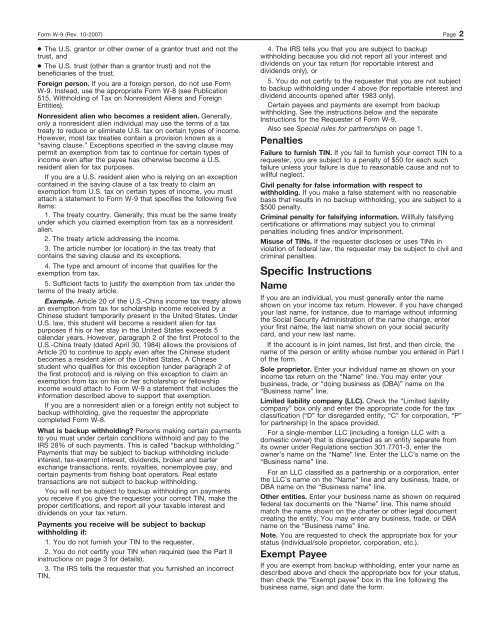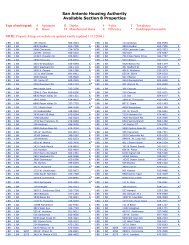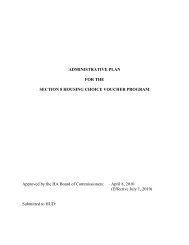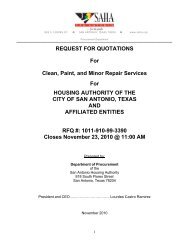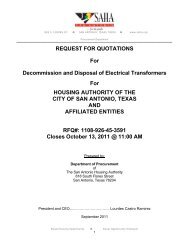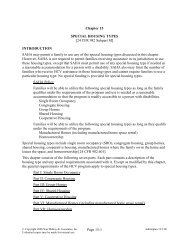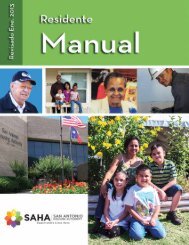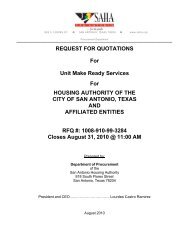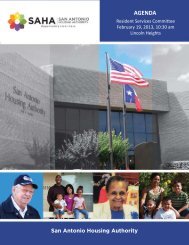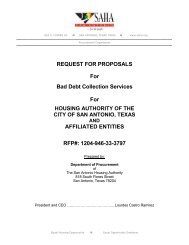REQUEST FOR QUOTATIONS For Clean, Paint, and Minor Repair ...
REQUEST FOR QUOTATIONS For Clean, Paint, and Minor Repair ...
REQUEST FOR QUOTATIONS For Clean, Paint, and Minor Repair ...
You also want an ePaper? Increase the reach of your titles
YUMPU automatically turns print PDFs into web optimized ePapers that Google loves.
<strong>For</strong>m W-9 (Rev. 10-2007) Page 2● The U.S. grantor or other owner of a grantor trust <strong>and</strong> not thetrust, <strong>and</strong>● The U.S. trust (other than a grantor trust) <strong>and</strong> not thebeneficiaries of the trust.<strong>For</strong>eign person. If you are a foreign person, do not use <strong>For</strong>mW-9. Instead, use the appropriate <strong>For</strong>m W-8 (see Publication515, Withholding of Tax on Nonresident Aliens <strong>and</strong> <strong>For</strong>eignEntities).Nonresident alien who becomes a resident alien. Generally,only a nonresident alien individual may use the terms of a taxtreaty to reduce or eliminate U.S. tax on certain types of income.However, most tax treaties contain a provision known as a“saving clause.” Exceptions specified in the saving clause maypermit an exemption from tax to continue for certain types ofincome even after the payee has otherwise become a U.S.resident alien for tax purposes.If you are a U.S. resident alien who is relying on an exceptioncontained in the saving clause of a tax treaty to claim anexemption from U.S. tax on certain types of income, you mustattach a statement to <strong>For</strong>m W-9 that specifies the following fiveitems:1. The treaty country. Generally, this must be the same treatyunder which you claimed exemption from tax as a nonresidentalien.2. The treaty article addressing the income.3. The article number (or location) in the tax treaty thatcontains the saving clause <strong>and</strong> its exceptions.4. The type <strong>and</strong> amount of income that qualifies for theexemption from tax.5. Sufficient facts to justify the exemption from tax under theterms of the treaty article.Example. Article 20 of the U.S.-China income tax treaty allowsan exemption from tax for scholarship income received by aChinese student temporarily present in the United States. UnderU.S. law, this student will become a resident alien for taxpurposes if his or her stay in the United States exceeds 5calendar years. However, paragraph 2 of the first Protocol to theU.S.-China treaty (dated April 30, 1984) allows the provisions ofArticle 20 to continue to apply even after the Chinese studentbecomes a resident alien of the United States. A Chinesestudent who qualifies for this exception (under paragraph 2 ofthe first protocol) <strong>and</strong> is relying on this exception to claim anexemption from tax on his or her scholarship or fellowshipincome would attach to <strong>For</strong>m W-9 a statement that includes theinformation described above to support that exemption.If you are a nonresident alien or a foreign entity not subject tobackup withholding, give the requester the appropriatecompleted <strong>For</strong>m W-8.What is backup withholding? Persons making certain paymentsto you must under certain conditions withhold <strong>and</strong> pay to theIRS 28% of such payments. This is called “backup withholding.”Payments that may be subject to backup withholding includeinterest, tax-exempt interest, dividends, broker <strong>and</strong> barterexchange transactions, rents, royalties, nonemployee pay, <strong>and</strong>certain payments from fishing boat operators. Real estatetransactions are not subject to backup withholding.You will not be subject to backup withholding on paymentsyou receive if you give the requester your correct TIN, make theproper certifications, <strong>and</strong> report all your taxable interest <strong>and</strong>dividends on your tax return.Payments you receive will be subject to backupwithholding if:1. You do not furnish your TIN to the requester,2. You do not certify your TIN when required (see the Part IIinstructions on page 3 for details),3. The IRS tells the requester that you furnished an incorrectTIN,4. The IRS tells you that you are subject to backupwithholding because you did not report all your interest <strong>and</strong>dividends on your tax return (for reportable interest <strong>and</strong>dividends only), or5. You do not certify to the requester that you are not subjectto backup withholding under 4 above (for reportable interest <strong>and</strong>dividend accounts opened after 1983 only).Certain payees <strong>and</strong> payments are exempt from backupwithholding. See the instructions below <strong>and</strong> the separateInstructions for the Requester of <strong>For</strong>m W-9.Also see Special rules for partnerships on page 1.PenaltiesFailure to furnish TIN. If you fail to furnish your correct TIN to arequester, you are subject to a penalty of $50 for each suchfailure unless your failure is due to reasonable cause <strong>and</strong> not towillful neglect.Civil penalty for false information with respect towithholding. If you make a false statement with no reasonablebasis that results in no backup withholding, you are subject to a$500 penalty.Criminal penalty for falsifying information. Willfully falsifyingcertifications or affirmations may subject you to criminalpenalties including fines <strong>and</strong>/or imprisonment.Misuse of TINs. If the requester discloses or uses TINs inviolation of federal law, the requester may be subject to civil <strong>and</strong>criminal penalties.Specific InstructionsNameIf you are an individual, you must generally enter the nameshown on your income tax return. However, if you have changedyour last name, for instance, due to marriage without informingthe Social Security Administration of the name change, enteryour first name, the last name shown on your social securitycard, <strong>and</strong> your new last name.If the account is in joint names, list first, <strong>and</strong> then circle, thename of the person or entity whose number you entered in Part Iof the form.Sole proprietor. Enter your individual name as shown on yourincome tax return on the “Name” line. You may enter yourbusiness, trade, or “doing business as (DBA)” name on the“Business name” line.Limited liability company (LLC). Check the “Limited liabilitycompany” box only <strong>and</strong> enter the appropriate code for the taxclassification (“D” for disregarded entity, “C” for corporation, “P”for partnership) in the space provided.<strong>For</strong> a single-member LLC (including a foreign LLC with adomestic owner) that is disregarded as an entity separate fromits owner under Regulations section 301.7701-3, enter theowner’s name on the “Name” line. Enter the LLC’s name on the“Business name” line.<strong>For</strong> an LLC classified as a partnership or a corporation, enterthe LLC’s name on the “Name” line <strong>and</strong> any business, trade, orDBA name on the “Business name” line.Other entities. Enter your business name as shown on requiredfederal tax documents on the “Name” line. This name shouldmatch the name shown on the charter or other legal documentcreating the entity. You may enter any business, trade, or DBAname on the “Business name” line.Note. You are requested to check the appropriate box for yourstatus (individual/sole proprietor, corporation, etc.).Exempt PayeeIf you are exempt from backup withholding, enter your name asdescribed above <strong>and</strong> check the appropriate box for your status,then check the “Exempt payee” box in the line following thebusiness name, sign <strong>and</strong> date the form.


